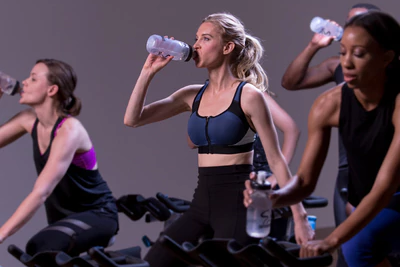By Chere Lucett
There’s something to the go-stop-go method of training. In fact there’s a lot to it. Metabolic training is not just myth or commercial fitness hype. Exercise researchers have backed up cardiovascular training with several studies crowning “metabolic training,” in all its forms, superior to the hum-drum get-on-the-bike-or-treadmill-and-coast kind of cardio.
What is metabolic training?
Metabolic training is simply a way of manipulating exercise variables like time, intensity and rest periods to impact your cardiovascular and metabolic response to exercise. Researchers have explored several variations of metabolic training, like high intensity interval training (HIIT), high intensity intermittent exercise (HIIE) or sprint interval training (SIT), and determined that it is one of the most beneficial forms of cardiorespiratory training1,6. In fact, current research shows that HIIT training, when implemented progressively, is safe and recommended for heart disease patients.3-5
Here are just a few examples of the power of metabolic (or interval) training1-7. It has been shown to:
- Decrease body fat more so than traditional cardiovascular training.
- Increase cardiometabolic efficiency.
- Provide greater levels of excess post-exercise oxygen consumption, or EPOC (the sensation that makes you sweat long after you’ve unclipped from your pedals. A longer EPOC means more calories burnt after the workout)
- Help improve strength and muscle mass.
- Burn equal amounts of calories when compared to longer duration, less intense exercise regimens.
- Rehabilitate those who suffer from heart disease and are at risk of heart failure
Moving into and out of different energy pathways changes the way your body metabolizes energy, and it can drastically change the way you fit into your skinny jeans!
Go. Stop. GASP!
Have you ever wondered why indoor cycling class instructors vary their tempos, intensity and durations? It’s not just because it’s fun, or the instructors want to torture you. It’s because each class is designed to enhance your conditioning.The science behind metabolic training is so intense it requires some serious study to understand the bioenergetics behind manipulating variables and incorporating the exact timing to successfully elicit the correct metabolic response. Thankfully, your instructors do all the hard work of learning how to precisely apply the science to your cycling class.
Here’s what you need to know
Metabolic training takes advantage of all the ways your body fuels and responds to exercise. And that means great things for your endurance, power, strength and body.There are two basic energy pathways, the aerobic pathway, which is the pathway you use when you are performing longer duration, low-intensity bouts of exercise, and the anaerobic pathway, which is what you use when you are performing shorter bouts of high-intensity exercise. These two pathways help support the body as you undergo variations in work demand. Slower, less intense demand means you are counting on the aerobic pathway to provide the energy required to fuel your workout. More demanding exercises require you to use the anaerobic pathways to fuel your workout. Metabolic training like HIIT or HIIE ups the ante of traditional cardiovascular training by increasing the work demand and manipulating the work periods, such as making your standing sprint longer and the rest periods shorter. This method of training moves you through various energy demands. These maneuverings push the body and cardiovascular system to varying extremes, increasing calorie burn and inducing metabolic changes.
Proceed with caution
While HIIT training is great for you, too much can be problematic. When you engage in classes with challenging physiological demands, you can easily head towards overtraining, injury and burnout. So remember to get ample rest between sessions. It’s not recommended to perform intense interval sessions every day. Completing them a few times a week will provide the most benefit while side-stepping the danger zone of overtraining. In addition, those new to Spinning® will want to start with lower intensities help develop their cardiovascular fitness before engaging in these higher intensity forms of training.
References
1. Brooks, G.A., Fahey, T.D., & White, T.P. (1996) Exercise physiology: Human bioenergetics and its application (2nd ed.). Mountain View, CA: Mayfield Publishing Company.
2. Russell, R.D.,, Nelson, A.G., & Kraemer, R.R. (2014). Short bouts of high-intensity resistance- style training produce similar reductions in fasting blood glucose of diabetic offspring and controls. Journal of Strength and Conditioning Research, 28(10), 2760-2767
3. Kessler, H.S., Sisson, S.B., Short, K.R. (2012). The potential for high-intensity interval training to reduce cardiometabolic disease risk. Sports Medicine, . 42(6), 489-509.
4. Wisløff, U., Støylen, A., Loennechen, J.P., Bruvold, M., Rognmo, Ø., Haram, P.M., Tjønna, A.E., Helgerud, J., Slørdahl, S.A., Lee, S.J., Videm, V., Bye, A., Smith, G.L., Najjar, S.M., Ellingsen, Ø., & Skjaerpe, T. (2007). Superior cardiovascular effect of aerobic interval training versus moderate continuous training in heart failure patients: a randomized study. Circulation, 115(24), 3086-3094.
5. Chrysohoou, C., Angelis, A., Tsitsinakis, G., Spetsioti, S., Nasis, I., Tsiachris, D., Rapakoulias, P., Pitsavos, C., Koulouris, N.G., Vogiatzis, I., & Dimitris, T. (2015). Cardiovascular effects of high-intensity interval aerobic training combined with strength exercise in patients with chronic heart failure. A randomized phase III clinical trial. International Journal of Cardiology, 179,269-274.
6. Shiraev, T. & Barclay, G. (2012). Evidence based exercise - clinical benefits of high intensity interval training. Australian Family Physician, 41(12), 960-962.
7. Willardson, J.M. (2006). A brief review: Factors affecting the length of the rest interval between resistance exercise sets. Journal of Strength and Conditioning Research, 20(4), 978-984.






Leave a comment
This site is protected by hCaptcha and the hCaptcha Privacy Policy and Terms of Service apply.